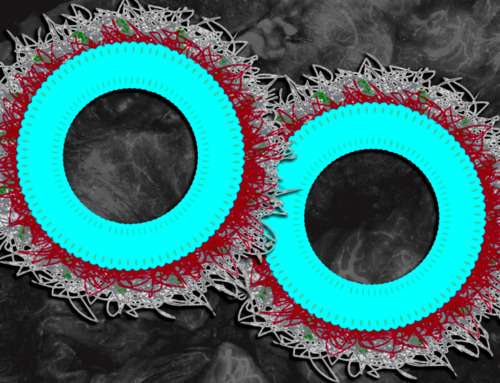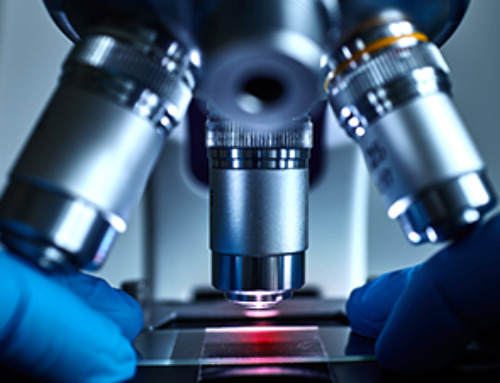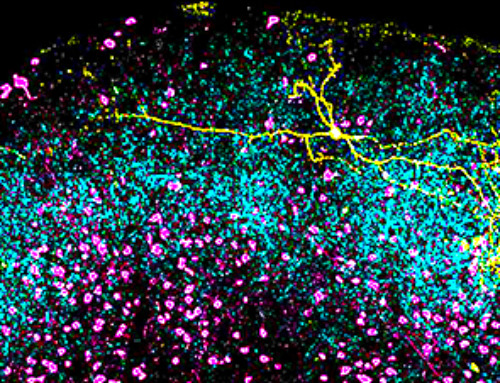| Using nanopore DNA sequencing technology, researchers from TU Delft and the University of Illinois have managed to scan a single protein: by slowly moving a linearized protein through a tiny nanopore, one amino acid at the time, the researchers were able to read off electric currents that relate to the information content of the protein. | |
| The researchers published their proof-of-concept in Science (“Multiple re-reads of single proteins at single-amino-acid resolution using nanopores”). The new single-molecule peptide reader marks a breakthrough in protein identification, and opens the way towards single-molecule protein sequencing and cataloguing the proteins inside a single cell. |
| Proteins are the workhorses of our cells, yet we simply don’t know what proteins we all carry with us. A protein is a long peptide string made of 20 different types of amino acids, comparable to a necklace with different kinds of beads. From the DNA blueprint, we are able to predict of which amino acids a protein consists. | |
| However, the final protein can greatly differ from the blueprint, for example due to post-translational modifications. Current methods to measure proteins are expensive, limited to large volumes, and they cannot detect many rare proteins. | |
| With nanopore-based technology, one is already able to scan and sequence single DNA molecules. The team led by Cees Dekker (TU Delft) now adapted this technique to instead scan a single protein, one amino acid at a time. | |
| “Over the past 30 years, nanopore-based DNA sequencing has been developed from an idea to an actual working device,” Cees Dekker explains. “This has even led to commercial hand-held nanopore sequencers that serve the billion-dollar genomics market. In our paper, we are expanding this nanopore concept to the reading of single proteins. This may have great impact on basic protein research and medical diagnostics.” | |
Like beads down the drain |
|
| The new technique reveals characteristics of even single amino acids within a peptide, but how? Lead author of the paper Henry Brinkerhoff, who pioneered this work as a postdoc in Dekker’s lab, explains: “Imagine the string of amino acids in one peptide molecule as a necklace with different-sized beads. Then, imagine you turn on the tap as you slowly move that necklace down the drain, which in this case is the nanopore. If a big bead is blocking the drain, the water flowing through will only be a trickle; if you have smaller beads in the necklace right at the drain, more water can flow through. With our technique we can measure the amount of water flow (the ion current actually) very precisely.” | |
| Cees Dekker enthusiastically adds: “A cool feature of our technique is that we were able to read a single peptide string again and again: we then average all the reads from that one single molecule, and thus identify the molecule with basically 100% accuracy.” | |
| This results in a unique read-off which is characteristic for a specific protein. When the researchers changed even one single amino acid within the peptide (‘a single bead within the necklace’), they obtained very different signals, indicating the extreme sensitivity of the technique. The group led by Alek Aksimentiev at the University of Illinois performed molecular dynamics simulations that showed how the ion current signals relate to the amino acids in the nanopore. | |
Scanning the barcode for identification |
|
| The new technique is very powerful for identifying single proteins and mapping minute changes between them – much like how a cashier in the supermarket identifies each product by scanning its barcode. It also may provide a new route towards full de novo protein sequencing in the future. | |
| Henry Brinkerhoff clarifies: “Our approach might lay a basis for a single-protein sequencer in the future, but de novo sequencing remains a big challenge. For that, we still need to characterize the signals from a huge number of peptides in order to create a ‘map’ connecting ion current signals to protein sequence. Even so, the ability to discriminate of single-amino-acid substitutions in single molecules is a major advance, and there are many immediate applications for the technology as it is now…..” |
News
New nanoparticles stimulate the immune system to attack ovarian tumors
Cancer immunotherapy, which uses drugs that stimulate the body’s immune cells to attack tumors, is a promising approach to treating many types of cancer. However, it doesn’t work well for some tumors, including ovarian [...]
New Drug Kills Cancer 20,000x More Effectively With No Detectable Side Effects
By restructuring a common chemotherapy drug, scientists increased its potency by 20,000 times. In a significant step forward for cancer therapy, researchers at Northwestern University have redesigned the molecular structure of a well-known chemotherapy drug, greatly [...]
Lipid nanoparticles discovered that can deliver mRNA directly into heart muscle cells
Cardiovascular disease continues to be the leading cause of death worldwide. But advances in heart-failure therapeutics have stalled, largely due to the difficulty of delivering treatments at the cellular level. Now, a UC Berkeley-led [...]
The basic mechanisms of visual attention emerged over 500 million years ago, study suggests
The brain does not need its sophisticated cortex to interpret the visual world. A new study published in PLOS Biology demonstrates that a much older structure, the superior colliculus, contains the necessary circuitry to perform the [...]
AI Is Overheating. This New Technology Could Be the Fix
Engineers have developed a passive evaporative cooling membrane that dramatically improves heat removal for electronics and data centers Engineers at the University of California San Diego have created an innovative cooling system designed to greatly enhance [...]
New nanomedicine wipes out leukemia in animal study
In a promising advance for cancer treatment, Northwestern University scientists have re-engineered the molecular structure of a common chemotherapy drug, making it dramatically more soluble and effective and less toxic. In the new study, [...]
Mystery Solved: Scientists Find Cause for Unexplained, Deadly Diseases
A study reveals that a protein called RPA is essential for maintaining chromosome stability by stimulating telomerase. New findings from the University of Wisconsin-Madison suggest that problems with a key protein that helps preserve chromosome stability [...]
Nanotech Blocks Infection and Speed Up Chronic Wound Recovery
A new nanotech-based formulation using quercetin and omega-3 fatty acids shows promise in halting bacterial biofilms and boosting skin cell repair. Scientists have developed a nanotechnology-based treatment to fight bacterial biofilms in wound infections. The [...]
Researchers propose five key questions for effective adoption of AI in clinical practice
While Artificial Intelligence (AI) can be a powerful tool that physicians can use to help diagnose their patients and has great potential to improve accuracy, efficiency and patient safety, it has its drawbacks. It [...]
Advancements and clinical translation of intelligent nanodrugs for breast cancer treatment
A comprehensive review in "Biofunct. Mater." meticulously details the most recent advancements and clinical translation of intelligent nanodrugs for breast cancer treatment. This paper presents an exhaustive overview of subtype-specific nanostrategies, the clinical benefits [...]
It’s Not “All in Your Head”: Scientists Develop Revolutionary Blood Test for Chronic Fatigue Syndrome
A 96% accurate blood test for ME/CFS could transform diagnosis and pave the way for future long COVID detection. Researchers from the University of East Anglia and Oxford Biodynamics have created a highly accurate [...]
How Far Can the Body Go? Scientists Find the Ultimate Limit of Human Endurance
Even the most elite endurance athletes can’t outrun biology. A new study finds that humans hit a metabolic ceiling at about 2.5 times their resting energy burn. When ultra-runners take on races that last [...]
World’s Rivers “Overdosing” on Human Antibiotics, Study Finds
Researchers estimate that approximately 8,500 tons of antibiotics enter river systems each year after passing through the human body and wastewater treatment processes. Rivers spanning millions of kilometers across the globe are contaminated with [...]
Yale Scientists Solve a Century-Old Brain Wave Mystery
Yale scientists traced gamma brain waves to thalamus-cortex interactions. The discovery could reveal how brain rhythms shape perception and disease. For more than a century, scientists have observed rhythmic waves of synchronized neuronal activity [...]
Can introducing peanuts early prevent allergies? Real-world data confirms it helps
New evidence from a large U.S. primary care network shows that early peanut introduction, endorsed in 2015 and 2017 guidelines, was followed by a marked decline in clinician-diagnosed peanut and overall food allergies among [...]
Nanoparticle blueprints reveal path to smarter medicines
Lipid nanoparticles (LNPs) are the delivery vehicles of modern medicine, carrying cancer drugs, gene therapies and vaccines into cells. Until recently, many scientists assumed that all LNPs followed more or less the same blueprint, [...]





















